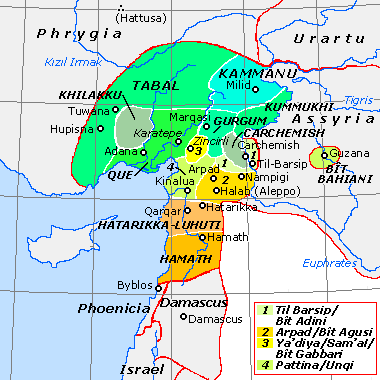Quwê
Quwê – also spelled Que, Kue, Qeve, Coa, Kuê and Keveh – was a Syro-Hittite Assyrian vassal state or province at various times from the 9th century BCE to shortly after the death of Ashurbanipal around 627 BCE in the lowlands of eastern Cilicia, and the name of its capital city, tentatively identified with Adana, in modern Turkey. The name Que reflects the Assyrian transmission of the indigenous name Hiyawa,[1] the same state is known as Hume from Babylonian sources. The question whether the toponym Hiyawa is related to Ahhiyawa, the Hittite designation of Mycenaean Greeks, is at present hotly debated.[2] The principal argument in favour of a Greek migration into Cilicia at the end of the Bronze Age is the mention of Muksa/Mopsos as the founder of the local dynasty in indigenous Luwian and Phoenician inscriptions.[3] According to many translations of the Bible, Quwê was the place from which King Solomon obtained horses. (I Kings 10: 28, 29; II Chron. 1:16)
Quwê Adanawa/Ḫiyawa | |||||||||
|---|---|---|---|---|---|---|---|---|---|
| Unknown–at least 7th century BC | |||||||||
 Quwê and its capital Adana among the Neo-Hittite states | |||||||||
| Capital | Adana | ||||||||
| Common languages | Hieroglyphic Luwian | ||||||||
| Religion | Luwian religion | ||||||||
| Government | Monarchy | ||||||||
| Historical era | Iron Age | ||||||||
• Established | Unknown | ||||||||
• Disestablished | at least 7th century BC | ||||||||
| |||||||||
| Today part of | |||||||||
The species name of Cyclamen coum probably refers to Quwê.[4]
See also
- Ancient regions of Anatolia
- Cinekoy inscription
- Karatepe Bilingual
References
- Trevor Bryce, The land of Hiyawa (Que) revisited, Anatolian Studies 66 (2016): 67–79
- Max Gander, Ahhiyawa – Hiyawa – Que: Gibt es Evidenz für die Anwesenheit von Griechen in Kilikien am Übergang von der Bronze- zur Eisenzeit? Studi Micenei ed Egeo-Anatolici 54 (2012): 281–309; Rostislav Oreshko, The Achаean hides caged in yonder beams: the value of Hieroglyphic Luwian sign *429 reconsidered and a new light on the Cilician Ahhiyawa, Kadmos 52.1: 19–33; Ilya Yakubovich, Phoenician and Luwian in Early Iron Age Cilicia, Anatolian Studies 65 (2015): 39a; J. David Hawkins, Addendum to ‘Phoenician and Luwian in Early Iron Age Cilicia’ by Ilya Yakubovich, Anatolian Studies 65 (2015): 54-55; Ilya Yakubovich, Adanawa or Ahhiyawa? Reply to the addendum by J.D. Hawkins, Anatolian Studies 65 (2015): 56-58; Rostislav Oreshko, Once again on the reading of Hieroglyphic Luwian sign *429: the evidence of the newly published ARSUZ inscriptions, N.A.B.U. 2015/3: 123-125
- Trevor Bryce, The land of Hiyawa (Que) revisited, Anatolian Studies 66 (2016): 74b
- Cyclamen coum subsp. coum Pink Silverleaf at Paghat's Garden
Sources
- Simo Parpola and Michael Porter, editors, The Helsinki Atlas of the Near East in the Neo-Assyrian Period, ISBN 951-45-9050-3 (Helsinki, Finland, 2001), Gazetteer, p. 15.
- Mirko Novák, Kizzuwatna, Ḥiyawa, Quwe – Ein Abriss der Kulturgeschichte des Ebenen Kilikien, in J. Becker / R. Hempelmann / E. Rehm (ed.), Kulturlandschaft Syrien – Zentrum und Peripherie. Festschrift für Jan-Waalke Meyer, Alter Orient und Altes Testament 371, Ugarit-Verlag Münster 2010, pp. 397–425.
- Cilicia Chronology Group: A Comparative Stratigraphy of Cilicia. Results of the first three Cilician Chronology Workshops, in: Altorientalische Forschungen 44/2, 2017, pp. 150–186.